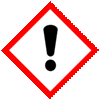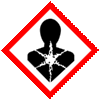| Aadhunik Industries is manufacturers of Ammonium Persulfate, Pharmaceutical Excipients in India. We offer Halal and Kosher Potassium Monopersulfate or Potassium Monopersulfate or Potassium peroxymonosulfate made in an ISO9001, ISO22000 (FSSC22000). We observe good manufacturing practice and good laboratory practice. |
| The units have one or more of the certifications like FDA GMP, ISO 9001, ISO 22000, HACCP, REACH, Kosher & Halal |

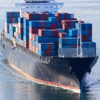

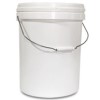
Ammonium Persulfate SDS of Suppliers Manufacturers
Ammonium Persulfate Specifications Sheet of Manufacturers.
CAS Number: 7727-54-0
Ammonium Persulfate
Ammonium Persulfate SDS Safety Data Sheet
MSDS Sheet, Material Safety Data Sheet
1. Product & Company Identification
Product Name & Other Names: Ammonium Persulfate or Ammonium Peroxydisulfate or Peroxydisulfuric Acid, Diammonium Salt or Diammonium peroxydisulfate.
CAS No.: 7727-54-0
EINECS EC Number: 231-786-5
2. Hazards Identification
GHS, Globally Harmonized System Classification in accordance with 29 CFR 1910
Classification according to Regulation (EC) No 1272/2008
Oxidizing Solids Category 3, H272
Acute toxicity - Oral Category 4, H302
Skin corrosion/irritation Category 2, H315
Serious eye damage/eye irritation Category 2A, H319
Respiratory sensitization Category 1, H334
Skin sensitization Category 1, H317
Specific target organ toxicity (single exposure) Category 3, H335
Labeling according to GHS & Regulation (EC) No 1272/2008
GHS Label Elements 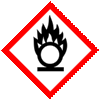 Oxidizing Solid |
GHS Label Elements |
GHS Label Elements |
Signal Word: Danger
Hazard Statements:
H272 - May intensify fire; oxidizer
H302 - Harmful if swallowed
H315 - Causes skin irritation
H317 - May cause an allergic skin reaction
H319 - Causes serious eye irritation
H334 - May cause allergy or asthma symptoms or breathing difficulties if inhaled
H335 - May cause respiratory irritation.
Precautionary Statements - Prevention
P210: Keep away from heat/sparks/open flames/hot surfaces. - No smoking.
P220: Keep/Store away from clothing/combustible materials
P221: Take any precaution to avoid mixing with combustibles
P261: Avoid breathing dust.
P264: Wash face, hands and any exposed skin thoroughly after handling
P270: Do not eat, drink or smoke when using this product
P271: Use only outdoors or in a well-ventilated area
P272: Contaminated work clothing should not be allowed out of the workplace.
P280: Wear protective gloves/ protective clothing/ eye protection/ face protection
P285: In case of inadequate ventilation wear respiratory protection
Precautionary Statements - Response
P301 + P312: IF SWALLOWED: Call a POISON CENTER or doctor if you feel unwell.
P302 + P352: IF ON SKIN: Wash with plenty of water.
P304 + P341: IF INHALED: If breathing is difficult, remove to fresh air and keep at rest in a position comfortable for breathing.
P305 + P351 + P338: IF IN EYES: Rinse cautiously with water for several minutes. Remove contact lenses, if present and easy to do. Continue rinsing.
P314: Get Medical advice/attention if you feel unwell.
P330: If swallowed, rinse mouth.
P333 + P313: If skin irritation or rash occurs: Get medical advice/ attention.
P337 + P313: If eye irritation persists: Get medical advice/ attention
P342 + P311: If experiencing respiratory symptoms: Call a POISON CENTER or doctor.
P362: Take off contaminated clothing and wash before reuse.
P370 + P378: In case of fire: Use water for extinction
Precautionary Statements - Storage
P402: Store in a dry place.
P403 + P233 - Store in a well-ventilated place. Keep container tightly closed.
3. Composition/Information on Ingredients
Product Name & Other Names: Ammonium Persulfate or Ammonium Peroxydisulfate or Peroxydisulfuric Acid, Diammonium Salt or Diammonium peroxydisulfate.
CAS No.: 7727-54-0
EINECS EC Number: 231-786-5
4. First Aid Measures
Always seek medical attention after first aid measures are provided.
Inhalation: Remove to fresh air. If not breathing, give artificial respiration. If breathing is difficult, give oxygen. Get medical attention.
Ingestion: If swallowed, do not induce vomiting. Give large quantities of water. Never give anything by mouth to an unconscious person. Get medical attention immediately.
Skin Contact: In case of contact, immediately flush skin with plenty of water for at least 15 minutes while removing contaminated clothing and shoes. Cover the irritated skin with an emollient. Cold water may be used. Wash clothing & shoes before reuse. Get medical attention.
Eye Contact: Check for and remove any contact lenses. In case of contact, immediately flush eyes with plenty of water for at least 15 minutes. Cold water may be used. Get medical attention.
5. Fire Fighting Measures
Fire: Ammonium Persulfate is not combustible, but substance is a strong oxidizer and its heat of reaction with reducing agents or combustibles may cause ignition.
Explosion: An explosion hazard when mixed with finely powdered organic matter, metal powder, or reducing agents.
Fire Extinguishing Media: Use water spray, alcohol-resistant foam, dry chemical, or carbon dioxide. Use means suitable for extinguishing surrounding fire. Cool containers with flooding quantities of water until well after fire is out.
Extinguishing Media Not recommended: None specified.
Special Information: In the event of a fire, wear full protective clothing and NIOSH-approved self-contained breathing apparatus with full face piece operated in the pressure demand or other positive pressure mode. At high temperatures under fire conditions, it may produce toxic or irritating fumes. Fire-extinguishing work is done from the windward and the suitable fire-extinguishing method according to the surrounding situation is used.
6. Accidental Release Measures
Personal precautions, protective equipment, and emergency procedures: Avoid breathing dust/fumes/gas/mist/vapors/spray. Use individual protective equipment (waterproof boots, suitable protective clothing, safety glasses, etc.). Restrict unprotected personnel from the area. Prevent any contact with hot surfaces. Do not approach facing the wind.
Environmental precautions: Do not let the product enter drains or ponds. Avoid contaminating soil and ground water.
Methods and materials used for containment cleanup procedures and Storage:
It is an oxidizing material. Contain spilled material. Cover with an inert, non-combustible, inorganic absorbent material, sweep up, and remove to an approved disposal container. Stop leak if without risk. Avoid contact with a combustible material (wood, paper, oil, clothing...). Keep the substance damp using water spray.
7. Handling and Storage
Precautions for safe handling: Apply according to good manufacturing and industrial hygiene practices with proper ventilation. Wash thoroughly after handling. Do not drink, eat, or smoke while handling. Avoid breathing dust/fumes/gas/mist/vapors/spray. Avoid contact with eyes, skin, and clothing. Keep container tightly closed. Avoid ingestion and inhalation. Use individual protective equipment (waterproof boots, suitable protective clothing, safety glasses, etc.). Prevent any contact with hot surfaces.
Conditions for safe storage, including any incompatibilities: Store in cool, dry, and ventilated area away from heat sources and protected from sunlight in tightly closed original container. Keep air contact to a minimum. Store protected from heat, sparks and ignition sources and incompatible materials. Do not store with incompatible materials like reducing agents, organic material, sodium peroxide, water, powdered metals especially aluminum, bases, halides, oxidizing agents, combustible materials. Avoid storage on wood floors.
8. Exposure Controls/Personal Protection
Airborne Exposure Limits: - ACGIH Threshold Limit Value (TLV): 0.1 mg/m3 (TWA) as persulfate
Ventilation System: A system of local and/or general exhaust is recommended to keep employee exposures below the Airborne Exposure Limits.Local exhaust ventilation is generally preferred because it can control the emissions of the contaminant at its source.
Personal Respirators (NIOSH Approved): For conditions of use where exposure to dust or mist is apparent and engineering controls are not feasible, a particulate respirator (NIOSH type N95 or better filters) may be worn. If oil particles (e.g., lubricants, cutting fluids, glycerin, etc.) are present, use a NIOSH type R or P filter.
Skin Protection: Wear protective gloves and clean body-covering clothing.
Eye Protection: Use chemical safety goggles. Maintain eye wash fountain and quick-drench facilities in work area.
Other Control Measures: Maintain good housekeeping in work area. Dust deposits on floors and other surfaces may pick up moisture and cause the surfaces to become slippery and present safety hazards. Handle in accordance with good industrial hygiene and safety practice.
9. Physical and Chemical Properties
Appearance: Ammonium Persulphate is white crystals
Odor: Odorless
Odor threshold: Not available.
pH: Not available.
Relative density: 1.98
Melting Point: 120C (248F) Decomposes
Initial boiling point and boiling range: Not available.
Flash point: Not available.
Auto-ignition temperature: Not available.
Decomposition temperature: Not available.
Upper/lower flammability or explosive limits: Not available.
Vapor pressure: Not available.
Vapor density: Not available.
Evaporation rate: Not available.
Flammability (solid, gas): Not available.
Partition coefficient: n-octanol/water: Not available.
Solubility: 80 g/l00 ml water @ 25C (77F)
Viscosity: Not available.
10. Stability and Reactivity
Stability: Stable under ordinary conditions of use and storage. Avoid moisture
Hazardous Decomposition Products: Decomposed by moisture. Burning may produce nitrogen oxides, sulfur oxides, and sulfuric acid. Oxygen is released which supports combustion.
Hazardous Polymerization: Will not occur
Incompatibilities: Reducing agents, organic material, water, and powdered metals, especially aluminum. acids, bases, halides, oxidizing agents, combustible materials.
Conditions to Avoid: Moisture, combustible materials, and incompatibles.
11. Toxicological Information
Oral rat LD50: 740 mg/kg
LD50 Dermal > 2000 mg/kg (rat) (Ammonium Persulfate)
LC50 Inhalation > 2.95 mg/L (rat) (4-hr) (Ammonium Persulfate)
Carcinogenicity: Not listed by ACGIH, IARC, NTP, or CA Prop 65.
Mutagenic Effects: Not found.
Reproductive Effects: No information found.
12. Ecological Information
Toxicity to fish: LC50 - Oncorhynchus mykiss (rainbow trout) - 76 mg/l - 96 h
Toxicity to daphnia and other aquatic invertebrates: EC50 - Daphnia magna(Water flea) - 120 mg/l - 48
Results of PBT and vPvB assessment: This substance/mixture contains no components considered to be either persistent, bioaccumulative and toxic (PBT), or very persistent and very bioaccumulative (vPvB) at levels of 0.1% or higher.
Persistence and Degradability: Unlikely to persist due to water solubility.
Mobility: Likely to be mobile due to water solubility.
Bioaccumulation/ Accumulation: No information found.
13. Disposal Considerations
Whatever cannot be saved for recovery or recycling should be handled as hazardous waste and sent to a RCRA approved waste facility. Processing use or contamination of this product may change the waste management options. Dispose of container and unused contents in accordance with federal, state, and local requirements.
14. Transport Information
DOT USA, TDG Canada & ADR/RID Europe:
UN/NA: UN1444
Proper Shipping Name: AMMONIUM PERSULFATE
Hazard Class: 5.1
Packing Group: III
IMDG/IMO & IATA/ICAO:
UN/NA: UN1444
Proper Shipping Name: AMMONIUM PERSULFATE
Hazard Class: 5.1
Packing Group: III
15. Regulatory Information
USA:
California No Significant Risk Level: None of the chemicals in this product are listed.
Section 16 - Additional Information
DISCLAIMER: The information and recommendations set forth herein are presented in good faith and believed correct as of the date hereof. It is compiled from various sources, and it is not necessarily all inclusive nor fully adequate in every circumstance. In addition, these suggestions should not be confused with nor followed in violation of applicable laws, regulations, rules, or insurance requirements applicable. This SDS MSDS sheet is intended only as a guide to the appropriate precautionary handling of the material by a professionally trained person using this product. Individuals receiving the information must exercise their independent judgment in determining its appropriateness for a particular purpose. This shall not constitute a guarantee for any specific product features and shall not establish a legally valid contractual relationship. In no case shall our company be liable to loss or damages by the product user.Ammonium Persulfate Manufacturers:
Aadhunik Industries
S-8, SARIFA MANSION, 2ND PRINCIPAL S H MARG, MUMBAI 400009, INDIA
TEL: (OFFICE) 91-22-23770100, 23726950, 23774610, 23723564. FAX: 91-22-23728264
e-mail: anmolc@mtnl.net.in
Exports to USA, Canada, UAE, Dubai, South Africa, Tanzania, Kenya, Nigeria, Egypt, Uganda, Turkey, Mexico, Brazil, Chile, Argentina, Europe Netherlands, Italy, Spain, Germany, Portugal, France, Malaysia, Indonesia, Thailand, Korea, Japan,etc.
It is nice to be important
But it is more important to be nice.
